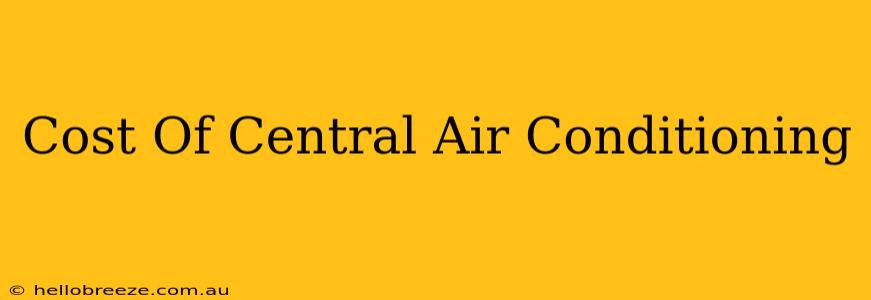Thinking about installing central air conditioning? Understanding the cost is the first crucial step. This comprehensive guide breaks down the factors influencing the price of central AC, helping you budget effectively and make informed decisions.
Factors Affecting Central Air Conditioning Costs
Several key factors determine the total cost of installing central air conditioning. Let's delve into each one:
1. System Size and Type:
This is arguably the biggest factor. A larger home or one with poor insulation will require a more powerful system, significantly increasing the upfront cost. The type of system – split system (most common), ductless mini-split, or geothermal – also impacts pricing. Ductless mini-splits are often less expensive initially, while geothermal systems, while energy-efficient in the long run, have a much higher initial investment.
2. Installation Complexity:
The complexity of the installation significantly affects the labor costs. Factors influencing this include:
- Existing Ductwork: If you already have ductwork suitable for central AC, installation will be cheaper. If new ductwork is needed, the cost can increase dramatically, especially in larger homes or those with complex layouts. This includes the potential need for attic access or crawlspace work.
- Home Accessibility: Difficult-to-reach areas or obstacles can add to labor time and therefore the overall cost.
3. SEER Rating and Energy Efficiency:
The Seasonal Energy Efficiency Ratio (SEER) rating measures how efficiently an air conditioner uses energy. Higher SEER ratings (generally 16 or above) mean lower energy bills in the long run, but they typically cost more upfront. Consider the long-term savings when evaluating this aspect. Don't forget to check for available rebates and incentives for energy-efficient models.
4. Additional Features:
Many central AC systems offer extra features like:
- Smart thermostats: These allow for remote control and energy optimization.
- Variable-speed blowers: Offer improved comfort and energy efficiency.
- Air purifiers: Improve indoor air quality.
- Zoned climate control: Allows you to adjust temperatures in different areas of your home.
These features enhance comfort and efficiency but increase the initial cost.
5. Labor Costs:
Labor costs vary by region and installer. Obtain multiple quotes to compare pricing and ensure you are getting a fair price for the installation work. This includes the cost of permits, which are typically a requirement.
6. Permits and Inspections:
Most areas require permits for central AC installations. These add to the overall cost, but are crucial for compliance and safety. Expect inspections to ensure proper installation and adherence to local codes.
Budgeting for Your Central Air Conditioning Installation
Getting an accurate cost estimate requires contacting several reputable HVAC contractors. When requesting quotes, ensure they include all aspects:
- System cost: Including the unit, ductwork (if needed), and refrigerant.
- Installation labor: Clearly itemized labor charges.
- Permits and inspections: The cost of obtaining necessary permits and undergoing inspections.
- Warranty: The length and coverage of the warranty offered.
Remember to compare quotes carefully, focusing on the overall value rather than just the lowest price. A slightly more expensive system with a better warranty and higher SEER rating can save money in the long run. Don't hesitate to ask questions; a reputable contractor will be happy to explain the pricing breakdown thoroughly.
Conclusion: Making the Right Choice
Investing in central air conditioning can significantly improve your home's comfort and value. By understanding the cost factors outlined above, you can effectively budget and make an informed decision that best suits your needs and budget. Remember to prioritize a reputable HVAC contractor with a proven track record. The investment in a reliable and efficient system will pay off in comfort, energy savings, and increased home value for years to come.

